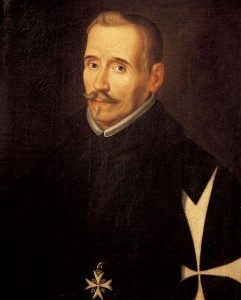Week 14: Wednesday, July 29, 2015
Lope de Vega

PART ONE: LECTURE:
Lope de Vega
(1562-1635)
Wikipedia on Lope de Vega:
Lope de Vega (1562 to 1635) was a Spanish playwright and poet. He was one of the key figures in the Spanish Golden Century Baroque literature. His reputation in the world of Spanish literature is second only to that of Cervantes, while the sheer volume of his literary output is unequalled, making him one of the most prolific authors in the history of literature. Nicknamed “The Phoenix of Wits” and “Monster of Nature” (because of the sheer volume of his work) by Miguel de Cervantes, Lope de Vega renewed the Spanish theatre at a time when it was starting to become a mass cultural phenomenon. He defined the key characteristics of it, and along with Calderón de la Barca and Tirso de Molina, he took Spanish baroque theatre to its greater limits. Because of the insight, depth and ease of his plays, he is regarded among the best dramatists of Western literature, his plays still being represented worldwide. He was also one of the best lyric poets in the Spanish language, and author of various novels. Although not well known in the English-speaking world, his plays were presented in England as late as the 1660s, when diarist Samuel Pepys recorded having attended some adaptations and translations of them, although he omits mentioning the author. Some 3,000 sonnets, 3 novels, 4 novellas, 9 epic poems, and about 1,800 plays are attributed to him. Although he has been criticised for putting quantity ahead of quality, nevertheless at least 80 of his plays are considered masterpieces. He was a friend of the writers Quevedo and Juan Ruiz de Alarcón, and the sheer volume of his lifework made him envied by not only contemporary authors such as Cervantes and Góngora, but also by many others: for instance, Goethe once wished he had been able to produce such a vast and colourful oeuvre.
REQUIRED READING:
Lope de Vega, Three Major Plays
We will read “El Fuente Ovejuna” in the collection cited above.
Also very useful is the introduction on theater in the age of Lope de Vega.
About the play, from Wikipedia:
“Fuenteovejuna” is a play by the Spanish playwright, Lope de Vega. First published in Madrid in 1619 as part of Docena Parte de las Comedias de Lope de Vega Carpio (Volume 12 of the Collected plays of Lope de Vega Carpio), the play is believed to have been written between 1612 and 1614. The play is based upon an actual historical incident that took place in the village of Fuenteovejuna (now called Fuente Obejuna) in Castile in 1476. While under the command of the Order of Calatrava, a commander, Fernán Gómez de Guzmán, mistreated the villagers, who banded together and killed him. When a magistrate sent by King Ferdinand II of Aragon arrived at the village to investigate, the villagers, even under the pain of torture, responded only by saying “Fuenteovejuna did it.”